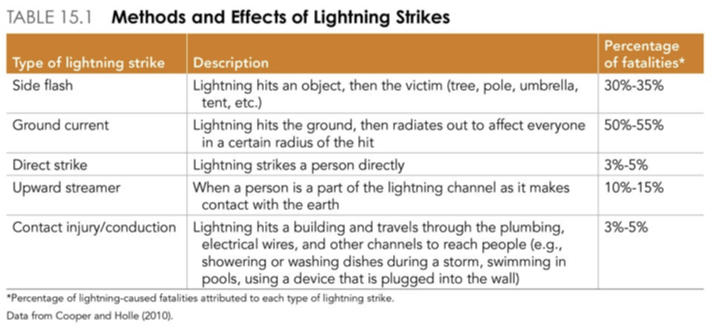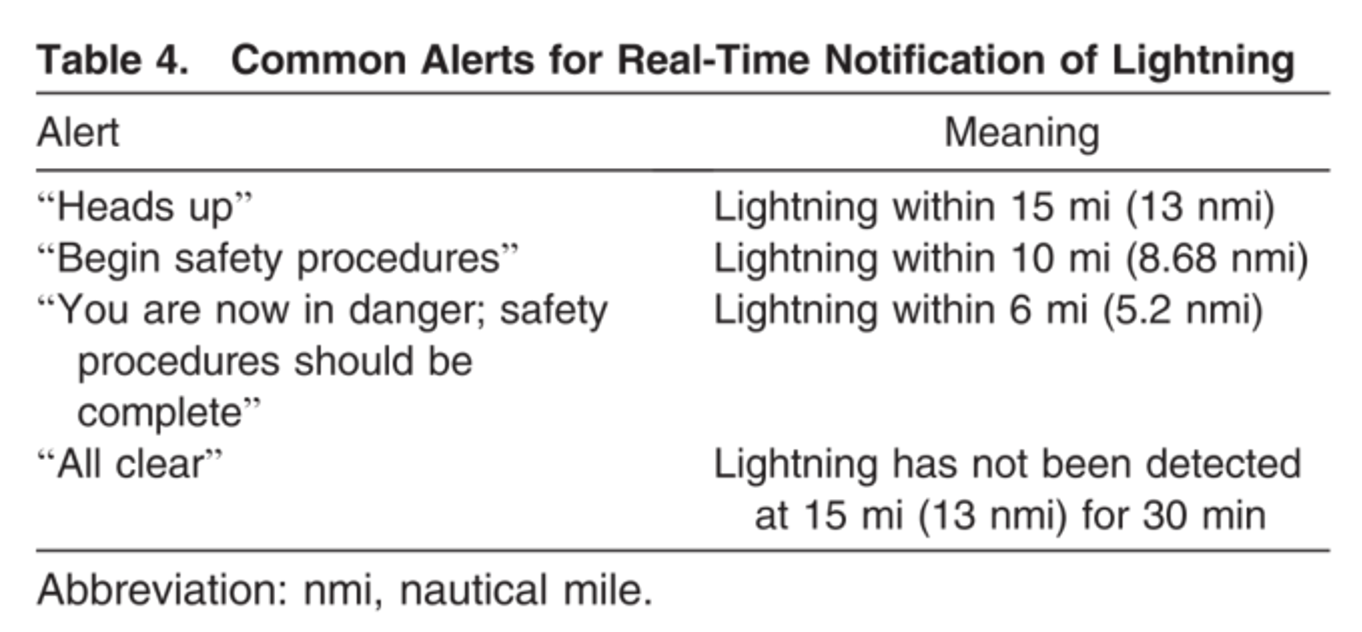Lightning Safety in Athletics
1/21
There's no tags or description
Looks like no tags are added yet.
Name | Mastery | Learn | Test | Matching | Spaced |
|---|
No study sessions yet.
22 Terms
Introduction
Most lightning related injuries are neurological in nature
Cardiac and respiratory arrest
Loss of consciousness
Seizures
Transitory paralysis to the extremities
Confusion and amnesia
Other lightning related injuries include:
Fractures
Internal organ damage
brain damage secondary to hypoxia
Epidural and subdural hematomas
Ruptured tympanic membranes
Ocular injuries
Epidemiology
The number of lightning related deaths decreased between 1968-85 from 130 to 85
◦Better resuscitation techniques
◦Better prevention methods
◦Decreased exposure
Age related risk
◦Lightning deaths are most common ages 10-14 and 15-19
◦About 2.5-3 per 100,000, respectively
Risk factors in athletics: Geography
Most lightning occurs in the eastern half of the united states
Area of high occurrence of lightning deaths due to lightning runs from New York to Florida and extends west to the Mississippi River
Mid atlantic states are among the highest in terms of lightning deaths
Risk Factors: Time of Day
Most lightning deaths occurred between 3 and 7 pm
95% of deaths occurred between Noon and 8pm
Risk factors: locality
Outdoor athletic events most often occur on flat, open areas
fields
tracks
Very rarely is there appropriate protection from the elements
If there is protection, it is unlikely that it can accommodate participants, officials, and spectators
Risk factors: Summary
In terms of lightning risk, athletic events often occur at the worst possible time and the worst locations for us:
◦April to September
◦Practices and games usually mid afternoon to early evening
◦Eastern half of the United States
◦Mid-Atlantic Region
◦Inadequate protection at sites
Lightning Emergencies
A single bolt can strike a playing field, and the ramification of that strike can radiate out affecting nearly everyone within the area.
Ground current is most common cause of death related to lightning
Any lightning is dangerous (including cloud to cloud)

Prevention Strategies
Preparation
become aware of your regions typical thunderstorm activity pattern
prevailing weather patters and direction
time of day storms typically form
Have a plan of action if thunderstorms do occur in the area you are located
Develop a lightning safety policy for your teams or institution to follow in the case of severe weather
Check the weather report the morning of the event at the very minimum
television, radio, daily newspaper
Awareness of Storm Development
Recognize the development of conditions which are prime for thunderstorms
high heat
high humidity
Cumulus clouds which develop vertical towers
- characterized by a rounded bubble of cloud at the top
National Weather Service Guidelines
When should Activities Stopped?
In general, a significant lightning threat extends outward from the base of a thunderstorm cloud about 6 to 10 miles. It’s important to account for the time it will take for everyone to get to safety. Here are some criteria that could be used to stop activities.
If you see lightning. The ability to see lightning varies depending on the time of day, weather conditions, and obstructions such as trees, mountains, etc. In clear air, and especially at night, lightning can be seen from storms more than 10 miles away provided that obstructions don’t limit the view of the thunderstorm.
If you hear thunder. Thunder can usually be heard for a distance of about 10 miles provided that there is no background noise. Traffic, wind, and precipitation may limit the ability to hear thunder to less than 10 miles. If you hear thunder, though, it’s a safe bet that the storm is within ten miles
If the skies look threatening. Thunderstorms can develop directly overhead and some storms may develop lightning just as they move into an area.

Lightning EAP!!
Safe Shelter
Buildings normally occupied by people
Large metal buildings connected to ground
Residences
Vehicles with solid metal tops such as automobiles, busses, vans
Unsafe Shelter
Metal topped structures with non conducting walls
Small buildings not connected to ground
sheds
Under trees or other tall objects
Stay away from poles, antennas, or towers
Return to Activity
Allow 30 minutes to pass after the last sound of thunder or flash of lightning before returning to activity
As many lightning injuries occur after the peak lightning activity as before
low flash rate periods had more casualties than high rate periods
Medical Consequences of Lightning strikes
50% of people struck by lightning will experience a ruptured tympanic membrane
Fractures and contusions from being thrown by the air explosion resulting from lightning
Concussions, ocular trauma, or burns
Cardiac arrest
Neurological system is most susceptible to injury and long-term consequences
When treating victims of lightning, treat the apparently dead first (opposite of usual trauma triage)
S/SX of lightning strikes
Usually obvious; thunderstorm is present
Alert patients; may be dazed or confused (concussion-like symptoms)
Field Assessment techniques for lightning strikes
The environment must be safe for HCP
30 minutes without seeing lightning or hearing thunder
There is limited data to determine true accuracy of various lighting detectors or apps
look for ones with external (not the company) research and validation
Use National Weather Service slogan: “When thunder roars, go indoors”
Follow normal assessment for a patient
key is to quickly determine whether a patient can be moved inside or somewhere else
Diagnostic Accuracy of Lightning Strikes
No specific diagnostic tools to determine lightning injury
A victim of an unwitnessed lightning strike may be unconscious or semiconscious
Clothing may be torn like they were attacked; indicates possible lightning strike
Lichtenberg figure
◦ Distinctive feathering marking found on lightning strike victims
◦ Transient sign; dissipates over time
Immediate Management Techniques for Lightning Strikes
Patients are to be treated for the trauma sustained
Each victim will have different injuries and should thus be treated for their respective injuries
If patient is unconscious, always assume a cervical spine injury and treat accordingly
if patient is not breathing and no pulse is present, activate CPR and EMS; apply an AED
Criteria for deciding to transport
Consider transporting lightning strike victims to a health care facility as one would any other patient
Transport anyone who is unresponsive, semiconscious, or has signs of shock
Patients who are unstable, have open fractures, dislocations, or possibility of a cervical spine injury must be stabilized and sent via ambulance to an appropriate medical facility